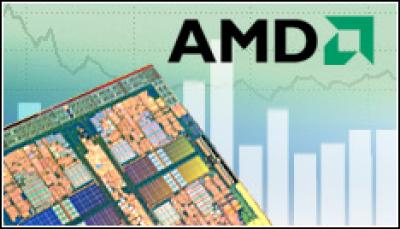AMD Posts Loss But Up On Year Ago

AMD posts another quarterly financial loss, but the results show some improvement over AMD’s performance from a year ago
Advanced Micro Devices posted another quarterly financial loss July 21, but the chip maker’s results were better than a year ago and the company plans to improve its position with new Opteron processors for servers, as well as several new laptop platforms.
Although AMD posted a loss in the second financial quarter of 2009, CEO Dirk Meyer offered some cautious optimism for the second half of 2009. In the first half of the year, Meyer said AMD worked on controlling its costs, which could pay dividends in the second half of the year if the overall world economy improves.
“With a strong flow of new products and a leaner cost structure, coupled with assumption of modest seasonal growth, we are positioned for a stronger financial performance in the second half of this year,” Meyer said during a call with financial analysts.
For now, Meyer said AMD would focus on its new generation of Opteron processors for server systems. By the fourth quarter of 2009, the majority of AMD’s Opteron processors should have been switched to 45-nanometer manufacturing.
In addition, AMD plans to launch several new platforms for laptops in the third quarter. One of these platforms is “Tigris,” which is geared toward mainstream notebooks. AMD also plans to roll out a new platform for what the company calls “thin and light” notebooks.
AMD also plans to focus on its ATI graphics technology in the second half of 2009, especially its support for Microsoft’s DirectX 11 technology for Windows 7, as well as graphics for the professional workstation market.
For the second financial quarter of 2009, AMD reported a net loss of $330 million (£202m) or 49 cents per share. Revenue for the quarter hit $1.18 billion. Wall Street analysts had called for a net loss of 47 cents per share and revenue of $1.13 billion.
Although AMD has reported yet another loss, the latest numbers were improved compared ith a year ago, when the chip maker posted a net loss of $1.95 billion or $1.97 per share and revenue of $1.35 billion.
John Spooner, an analyst with Technology Business Research, told eWEEK in an e-mail that AMD’s numbers were a positive sign that the company might be ready to turn itself around.
“The chip maker, like its rival Intel, showed sequential improvement in revenue,” Spooner wrote. “Unit shipments fared reasonably well, with some improvement in the server space. Thus there are signs that point to AMD’s business improving and the company marching toward its goal of becoming profitable (at least on a quarterly operating basis) in the second half of the year.”
However, there were troubling signs in AMD’s quarterly report, Spooner wrote. These included falling prices for the company’s laptop processors as consumers shop for cheaper notebooks and less expensive netbooks.
What AMD’s latest quarterly results mean for the semiconductor market and the overall IT industry are murky since no one is sure when consumers and businesses will begin buying hardware, such as PCs, in significant numbers again.
However, there are some signs that at least the chip industry is stabilising.
Earlier in July, Intel reported solid second-quarter numbers, including $8 billion in revenue and nearly $1 billion in profits. Although Intel had to report the quarter as a loss due to a massive fine from the European Commission, the numbers seemed to indicate a better second half for Intel and maybe for the entire semiconductor industry.
On 20 July, research company iSuppli released a report showing that after several quarters of significant declines, global chip inventories were expected to only decline 1.5 percent in the second quarter of 2009, as semiconductor companies adjusted their inventories and cut chip prices.
At the end of the second quarter of 2009, global chip inventories stood at about $25 billion after peaking at $32 billion in the second quarter of 2008.
The iSuppli report also predicted that worldwide chip revenues should increase about 7 percent in the second quarter after declining nearly 19 percent in the first quarter of 2009. Revenues are expected to increase 10 percent in the third quarter and approximately 5 percent in the fourth quarter.